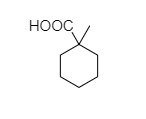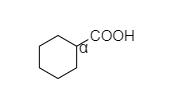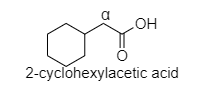
Which compound does not give HVZ reaction?
(A)
(B) 
(C) 
(D) 
Answer
440.2k+ views
1 likes
Hint: HVZ stands for Hell-Volhard-Zelinsky halogenation reaction. The HVZ reaction is halogenation of carboxylic acids at alpha carbon.
Complete step by step solution:
> This reaction is generally carried out by treating carboxylic acids with halogen in the presence of red phosphorus and then works up with water.
> Those compounds which have alpha hydrogen show HVZ reaction while those which do not have alpha hydrogen do not show HVZ reaction.
- In this
- In cyclohexyl carboxylic acid, alpha hydrogen is present as shown below,

So, this compound also shows the Hell-Volhard-Zelinsky halogenation reaction.
- In 1-methylcyclohexane-1-carboxylic acid, there is no alpha hydrogen present as the carbon is attached to 4 different bonds. So, this compound does not show the Hell-Volhard-Zelinsky halogenation reaction.
- In 2-cyclohexyl acetic acid, alpha hydrogen is present as shown in the figure;

Hence, this compound shows the HVZ reaction. The correct option is C.
Note: The possibility to make a mistake is that this reaction is specific for the replacement of alpha-hydrogens and not beta- hydrogens.
Complete step by step solution:
> This reaction is generally carried out by treating carboxylic acids with halogen in the presence of red phosphorus and then works up with water.
> Those compounds which have alpha hydrogen show HVZ reaction while those which do not have alpha hydrogen do not show HVZ reaction.
- In this
- In cyclohexyl carboxylic acid, alpha hydrogen is present as shown below,

So, this compound also shows the Hell-Volhard-Zelinsky halogenation reaction.
- In 1-methylcyclohexane-1-carboxylic acid, there is no alpha hydrogen present as the carbon is attached to 4 different bonds. So, this compound does not show the Hell-Volhard-Zelinsky halogenation reaction.
- In 2-cyclohexyl acetic acid, alpha hydrogen is present as shown in the figure;

Hence, this compound shows the HVZ reaction. The correct option is C.
Note: The possibility to make a mistake is that this reaction is specific for the replacement of alpha-hydrogens and not beta- hydrogens.
Latest Vedantu courses for you
Grade 10 | MAHARASHTRABOARD | SCHOOL | English
Vedantu 10 Maharashtra Pro Lite (2025-26)
School Full course for MAHARASHTRABOARD students
₹33,300 per year
EMI starts from ₹2,775 per month
Recently Updated Pages
How to find Oxidation Number - Important Concepts for JEE

How Electromagnetic Waves are Formed - Important Concepts for JEE

Electrical Resistance - Important Concepts and Tips for JEE

Average Atomic Mass - Important Concepts and Tips for JEE

Chemical Equation - Important Concepts and Tips for JEE

Concept of CP and CV of Gas - Important Concepts and Tips for JEE

Trending doubts
JEE Main 2025 Session 2: Application Form (Out), Exam Dates (Released), Eligibility, & More

JEE Main Exam Marking Scheme: Detailed Breakdown of Marks and Negative Marking

JEE Main 2025: Derivation of Equation of Trajectory in Physics

Electric Field Due to Uniformly Charged Ring for JEE Main 2025 - Formula and Derivation

Types of Solutions

Degree of Dissociation and Its Formula With Solved Example for JEE

Other Pages
NCERT Solutions for Class 12 Chemistry Chapter 6 Haloalkanes and Haloarenes

NCERT Solutions for Class 12 Chemistry Chapter 2 Electrochemistry

NCERT Solutions for Class 12 Chemistry Chapter 7 Alcohol Phenol and Ether

NCERT Solutions for Class 12 Chemistry Chapter 1 Solutions

Solutions Class 12 Notes: CBSE Chemistry Chapter 1

JEE Advanced Marks vs Ranks 2025: Understanding Category-wise Qualifying Marks and Previous Year Cut-offs




